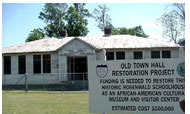Princeville
See also: James City.
Princeville, an Edgecombe County town incorporated in 1885, originated in 1865 as a resettlement community for newly-emancipated enslaved people. At the close of the Civil War, when Union troops occupied the area around Tarboro, many of the formerly enslaved people in surrounding counties left their plantations and their enslavers and came to the Federals' encampment seeking freedom and protection.
Formerly enslaved people congregated around the Union troops bivouacked on the south side of the Tar River below Tarboro. Although the soldiers advised them to return to the plantations and continue working for their enslavers, a sizable number of freedpeople remained encamped at the site after the troops had departed. They called their new village Freedom Hill (or sometimes Liberty Hill), a name adopted from a nearby hill or knoll where northern soldiers had addressed the formerly enslaved people, telling them that the Union victory in the war had made them free. The knoll where the soldiers made their speeches was on the west side of Old Sparta Road near what is now the intersection of U.S. 64 and U.S. 258.
The formerly enslaved people who remained encamped on the river soon erected makeshift shelters. White landowners made no effort to evict them from the land, which was so swampy that it was otherwise useless. In fact there is some evidence that the "squatters" were encouraged by white members of the community to remain at the site and thus keep their distance from the white community in Tarboro. In the 1870s, the landowners began selling lots to the black "squatters." One of the buyers was Turner Prince (1843-1912), a carpenter for whom the community was renamed upon its incorporation in 1885. James City, located across the Trent River from New Bern, had origins similar to those of Princeville but remained unincorporated.
Princeville's economy grew in the late nineteenth and early twentieth centuries, as black-owned businesses proliferated, but the rise of white supremacy campaigns of violence and political platforms brought a serious threat to Princeville's continued existence as a black town. Despite mounting calls for the town's dissolution, residents resisted, and today the town remains a cohesive black community. In 1999, the town's struggle to survive the devastating flooding caused by Hurricane Floyd became national news, leading to a number of public and private relief efforts.
Princeville's history is often compared to that of Eatonville, Fla., another "all-black" southern town that was incorporated in 1887. Being two years older, Princeville lays claim to being the "oldest city chartered by black people in America."
Educator Resources:
Grade 8: Against All Odds: The African American Founding of Princeville. North Carolina Civic Education Consortium. http://civics.sites.unc.edu/files/2012/04/Princeville.pdf
Reference:
Joe A. Mobley, "In the Shadow of White Society: Princeville, a Black Town in North Carolina, 1865-1915," NCHR 63 (July 1986).
Additional Resources:
Minnick, Beau. "With Princeville a pauper, state takes over town's books" WRAL.com. July 30, 2012. http://www.wral.com/news/local/story/11372403/ (accessed September 24, 2012).
"Freedom Hill." North Carolina Highway Historical Marker Program. https://www.ncdcr.gov/about/history/division-historical-resources/nc-highway-historical-marker-program/Markers.aspx?sp=Markers&k=Markers&sv=E-97 (accessed September 24, 2012).
"An act to incorporate "Princeville" in the county of Edgecombe." Laws and resolutions of the State of North Carolina, passed by the General Assembly at its session [1885]. p. 777-778. https://digital.ncdcr.gov/Documents/Detail/laws-and-resolutions-of-the-state-of-north-carolina-passed-by-the-general-assembly-at-its-session-1885/3889552?item=3924555
"Princeville, NC." The North Carolina Language and Life Project. NCSU Linguistics. https://www.ncsu.edu/linguistics/ncllp/sites/princeville.php (accessed September 24, 2012).
Boyd, Doug. "with history: Mural helps students learn lessons of yesterday and today." edge [East Carolina University]. Spring 2007. p.17-21. https://digital.ncdcr.gov/Documents/Detail/edge-2007-spring/1831784 (accessed September 24, 2012).
Rowe, Ryan and Grimes, Andrew. This Side of the River. http://thissideoftheriver.org (accessed September 24, 2012).
Image Credits:
Rowe, Ryan and Grimes, Andrew. This Side of the River PREVIEW. MySpace video. 5:05. Posted November 8, 2006. http://www.myspace.com/video/vid/3659351#pm_cmp=vid_OEV_P_P (accessed September 24, 2012).
"E-97c.jpg." North Carolina Highway Historical Marker Program. https://www.ncdcr.gov/about/history/division-historical-resources/nc-highway-historical-marker-program/marker_photo.aspx?sf=c&id=E-97 (accessed September 24, 2012).
1 January 2006 | Hill, Michael